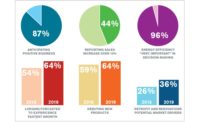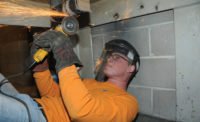According to at least one measure, contractors have a positive outlook heading into the New Year. The Air Conditioning Contractors of America (ACCA) reported that its December 2013 Contractor Comfort Index (CCI) measured 67, which was much better than 12 months earlier when it stood at 52. The CCI is calculated based on survey responses of ACCA contractor members when asked how positive they feel about new business prospects, existing business activity, and expected staffing decisions in the short-term future. A CCI of 50 or above reflects anticipated growth.
Dave Kyle, general manager, Trademasters Service Corp., Lorton, Va., and incoming ACCA chairman, is one contractor who definitely feels positive about prospects this year, noting that his company had an excellent year in 2013 and is looking forward to a fantastic 2014, as the economy continues its ascent. “But I do hear mixed results from other contractors. I think those who are adaptable and looking for opportunities are growing, while others may continue to struggle during the recovery.”
Optimistic Outlook
A contractor’s outlook may also vary depending on location, as some areas of the country are rebounding faster than others. For example, the Washington, D.C., area, where Trademasters is located, is growing rapidly, with people flocking to the region to work with or for the federal government. As Kyle noted, “Federal work has been great for us — it’s been a big part of our growth rate. We are also focused on the residential replacement market, and that has been steady as well. As far as commercial work is concerned, long-term building owners are looking to make energy improvements to their buildings, so that’s been beneficial.”
In particular, building owners are finally starting to replace older boilers and chillers with high-efficiency models. “Contractors should definitely look at the hydronic segment of the market, particularly the light to heavy commercial market. There is a big demand for high-efficiency equipment, as well as converting steam systems to hot water. Building owners can gain a lot of efficiencies that way,” said Kyle. “In addition, ductless multi-splits and VRF [variable-refrigerant flow] systems are taking off, and contractors should definitely be getting into that market.”
Randy Novak, president, Novak Heating & Air Conditioning Inc., Cedar Rapids, Iowa, and president, Sheet Metal and Air Conditioning Contractors’ National Association (SMACNA), also believes the economy will be a bit less of a concern in 2014. “Contractors seem slightly optimistic that work is picking up in many areas. Housing is an area we watch closely, and it seems that when housing is doing better, commercial and industrial work follow.”
To that end, many SMACNA members in the HVAC industry have seen some improvement in commercial, industrial, manufacturing, and residential markets in 2013, Novak said. “Overall, we see from all reports that the economy should continue to expand in 2014, unemployment rates should continue downward, and building activity should expand at a modest level across the nation — but could be strong in certain areas.”
Richard Starr, president and CEO, The Enterprise Corp. (Enterprise HVAC Service & Control), Twinsburg, Ohio, and chairman, Mechanical Service Contractors of America (MSCA), predicts that some contractors will do well in 2014, while others will continue to struggle. “The bigger companies will continue to get their market share, just because they’re large, and they have deep pockets that some end users interpret as security. If you’re a specialty contractor with a niche, you probably will do well, too. If you’re a plan-and-spec contractor, it’s going to be a real struggle. In fact, I think a lot of contractors will be happy if their sales stay flat with last year, accepting this as a new normal.”
Clouds on the Horizon
Medium-sized contractors may also face challenges going forward, said Starr. “One of the trends we’ve seen within MSCA is that medium-sized contractors are disappearing, which is a troublesome scenario. They’re either merging with other companies or else the owner is a baby boomer who has decided to close the doors and go home. If that trend keeps going, we’re going to end up with companies that are either two-men-and-a-truck or else a gorilla.”
Lack of investment in infrastructure is a main concern of Novak’s, who noted that it has led to a slow recovery by the construction industry. “Infrastructure spending is nearly $100 billion below trends seen in the last decade. That has been tough for many contractors expecting countercyclical investments by the federal government to offset restrictive fiscal policies at the state and local levels. Many SMACNA members perform public work, and this has made for a tight financial environment and slowed the economy for related industries.”
Novak added that SMACNA is also concerned about whether Congress and the administration will cooperate to pass appropriations, extensions of expiring tax provisions, and expiring programs that allow energy, pension, health and welfare, and financing laws to continue. “A productive Congress would benefit the economy, especially the HVAC and general construction industry. We have a full plate of issues to work on with Congress, but we know that energy tax incentives and pension reform will be at the top of a long list.”
Government Health Care
The Affordable Care Act (ACA), or Obamacare, is also causing uncertainty and confusion, Kyle said. “We want to be the employer of choice and provide access to benefits, but it’s really difficult when you don’t know what your long-term costs are going to be. We have seen consistent, significant double-digit increases in health care costs over the last three or four years.”
But Kyle sees a silver lining with the ACA, noting that it could provide a way to differentiate the HVAC industry from some of the other trades and ultimately provide contractors with an opportunity to attract and retain quality people. “There are really talented people out there in carpentry, construction, and auto repair who are looking for stability and benefits. If their companies don’t provide health care, there could be some talent available in the market very soon. Our industry is desperate for highly skilled, well-qualified people, and if we can retrain them and provide the benefits they’re looking for, then this could be an instance of turning lemons into lemonade.”
That would be good news to Starr, whose main concern is finding people who want to work in the HVAC industry. “I love this business. I find it so valuable and fulfilling. We solve problems every day. We create healthy buildings, we save people energy, and we minimize waste, which is fundamental to sustainability. But it takes people who are willing to wake up and go to work every day. Finding the young people who want to be in this industry — whether it’s engineering, service, installation, or sales — is a daily challenge, because the work can be physical and demanding. Today’s generation is so overwhelmed with social media that it makes one wonder if the work ethic is there to take the place of those departing baby boomers. Technology can’t replace everything.”
Publication date: 2/24/2014
Want more HVAC industry news and information? Join The NEWS on Facebook, Twitter, and LinkedIn today!







Report Abusive Comment